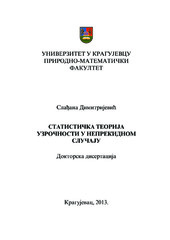Приказ основних података о дисертацији
Statistička teorija uzročnosti u neprekidnom slučaju
| dc.contributor.advisor | Petrović, Ljiljana | |
| dc.contributor.other | Janković, Svetlana | |
| dc.contributor.other | Bojović, Dejan | |
| dc.creator | Dimitrijević, Slađana | |
| dc.date.accessioned | 2016-01-05T13:05:36Z | |
| dc.date.available | 2016-01-05T13:05:36Z | |
| dc.date.available | 2020-07-03T15:08:01Z | |
| dc.date.issued | 2013-06-22 | |
| dc.identifier.uri | https://nardus.mpn.gov.rs/handle/123456789/3581 | |
| dc.identifier.uri | http://eteze.kg.ac.rs/application/showtheses?thesesId=329 | |
| dc.identifier.uri | https://fedorakg.kg.ac.rs/fedora/get/o:232/bdef:Content/download | |
| dc.description.abstract | Finding the cause or determining what is the cause and what is the consequence are probably one of the eldest problems of science. Philosophy from the beginning deals with these issues in the most general way, but other sciences also try to solve this kind of problems within their object of interest. Based on the results of Probability theory, Theory of random processes and Statistics, Statistical theory of causality originated as one of mathematical answers to the problem of determining causality in an arbitrary system. After the seminal papers of Granger (1969) and Sims (1972) many authors considered different types of stochastically defined causality. These researches mainly belong to predicting theory. Namely, the question of interest is: whether we can predict with the same accuracy in case of reduction of available information. At first, the researches were focused on discrete time stochastic processes (time series). However, as it is pointed out, there is a need for defining causality for continuous time stochastic processes, because many processes of interest have continuous time parameter. Namely, for financial time series is explained that even though the agents have only perceptions in discrete time, the underlying stochastic process of interest is in continuous time. Thus, the development of continuous time modeling in finance is important motivation for considering causality in continuous time. Also, the observed causality in a discrete time model may depend on the length of interval between each two successive samplings. Mykland (1986) and Florens and Fougères (1996) were the authors of first papers in which we can find definitions of causality in continuous time, given in terms of σ-algebras, i.e. natural filtrations of stochastic processes. Also, in Gill and Petrović (1987) and in Petrović (1996) definition of causality was given in continuous time, but in term of Hilbert spaces, i.e. L2-framework. Recently, there have been several papers which deal with these themes. The field of research in this dissertation is consideration of some causality concepts that are generalizations of Granger causality adopted for stochastic processes with continuous time. Also, same relationships of developed concept of causality and already existed related theories (adopted distributions) are considered. This dissertation, beside Preface and References with 86 items, consists of four chapters 1. Theory of random processes - basic notions; 2. Theory of causality - review of known results; 3. Generalization of Granger causality for stochastic processes with continuous time; 4. Causality and adopted distribution of stochastic processes. Chapter 1 is a brief overview of notions of theory of probability and stochastic processes that will be use later. Some known concepts of causality, both in discrete and in continuous case, are presented in Chapter 2. We followed the chronological development of the Statistical theory of causality, and special attention is given to the concepts that have contributed to our researches. Chapter 3 presents some generalizations of Granger causality adopted for stochastic processes with continuous time. Our original results, related to properties of developed concepts of causality, are given there. Specially we focused our attention to integration of stoping times into considered concept of causality, to invariance of causality under convergence and to relationship between causality and markovianity. Finally, in Chapter 4, we give connections between considered concept of causality and concept of adapted distribution of stochastic processes (specific concept of equivalence of stochastic processes), which introduced mathematicians from Model theory, Kiesler and Hoover | en |
| dc.format | application/pdf | |
| dc.language | sr | |
| dc.publisher | Универзитет у Крагујевцу, Природно-математички факултет | sr |
| dc.rights | openAccess | en |
| dc.rights.uri | https://creativecommons.org/licenses/by-nc/4.0/ | |
| dc.source | Универзитет у Крагујевцу | sr |
| dc.subject | Teorija verovatnoće | sr |
| dc.title | Statistička teorija uzročnosti u neprekidnom slučaju | sr |
| dc.type | doctoralThesis | en |
| dc.rights.license | BY-NC | |
| dcterms.abstract | Петровић, Љиљана; Јанковић, Светлана; Бојовић, Дејан; Димитријевић, Слађана; Статистичка теорија узрочности у непрекидном случају; Статистичка теорија узрочности у непрекидном случају; | |
| dc.identifier.fulltext | https://nardus.mpn.gov.rs/bitstream/id/47368/Disertacija.pdf | |
| dc.identifier.fulltext | http://nardus.mpn.gov.rs/bitstream/id/47368/Disertacija.pdf | |
| dc.identifier.doi | 10.2298/kg20130622dimitrijevic | |
| dc.identifier.rcub | https://hdl.handle.net/21.15107/rcub_nardus_3581 |


